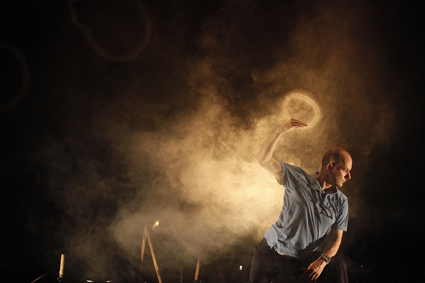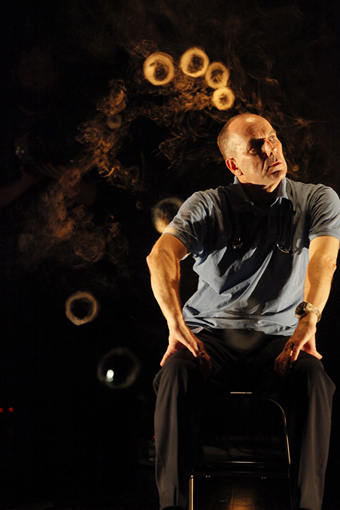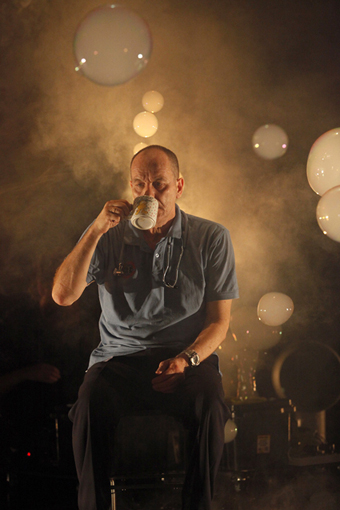more than smoke and mirrors
virginia baxter: ashley dyer, life support

Tony Osborne, Life Support, Ashley Dyer
photo Rachel Roberts
Tony Osborne, Life Support, Ashley Dyer
FIVE DAYS IN AT DANCE MASSIVE WITH SEVEN WORKS UNDER THE BELT, THOUGHTS INEVITABLY TURN TO EMERGING THEMES.
Gudirr, Gudirr aside, social issues have made way for more conceptual investigations: Stephanie Lake’s experiment in emotional mathematics (Dual); Antony Hamilton’s study in negative space (Black Study 1 & 2); Lee Serle’s provocative play with the viewer’s point of reference (P.O.V); Natalie Abbott’s attempt to shift our perception of time (Physical Fractals) and Larissa McGowan’s skeletal choreography (Skeleton). To these we now add Ashley Dyer’s meditation on the motion of smoke in Life Support.
In each of these works the sensory apparatus of the audience is primary. In Dual a good memory for movement will enhance your pleasure; in Black Study 1 & 2, you will be aided by 20-20 vision; not surprisingly, the experience of P.O.V is linked to your feel for the best seat; Physical Fractals tests your capacity for endurance while randomly depriving you of sight and turning up the audio till it literally threatens to clout you.
At the same time, there’s a distinct demand for heavy lifting from the dancers at Dance Massive who are required to subject their bodies to all sorts of extremes. Small wonder that over at the National Dance Forum facilitators have been prodding the artists assembled to answer the question, “Why dance?”

Tony Osborne, Life Support, Ashley Dyer
photo Rachel Roberts
Tony Osborne, Life Support, Ashley Dyer
Ashley Dyer’s Life Support is an intriguing work that while ostensibly focussing on an elemental phenomenon, like Natalie Abbott’s Physical Fractals, also offers insights into the capacities for endurance from both performer and audience.
At the outset we are asked to elect one among us to act on our behalf to end the performance we are about to witness. In our case, the choice is between a young man who saved someone from drowning and a woman who saw her suffering boyfriend through the flu. A quick show of hands for the boy wonder, an OHS warning, oxygen canisters all round and we confidently enter the performative arena.
What transpires was apparently inspired in part for Ashley Dyer by the sight of a nurse taking a break for a cigarette outside a hospital. Standing in for the nurse, performer Tony Osborne seated in the centre of the room rolls and lights up a cigarette. Those of us who remember the days when this apparently innocent ritual combined mindfulness with impaired respiration are momentarily nostalgic. These days we worry at the mere sight of any actor required to smoke. The vapour from the cigarette is transformed into elegant rings generated not by the smoker but by a technician circling him in the dark. Though the apparatus is awkward, the effect is mesmerising. The performer moves through a sequence of poses, but is now much less interesting to us than everything that is happening around him. Smoke circles drift above his head or around his body and wobble towards us. Large and small they dance for a moment and then crash into Osborne’s head or dissolve in air. The circles are joined by bubbles filled with smoke that give us more joy as they bounce and break, emptying their curly contents.
All this playful pleasure takes a dark turn as an assistant places a box around the performer and slowly wraps it in plastic. As this is happening, we note the play of smoke across the floor is now a flood and that the stuff is also seeping over the top of the doors to the space. The box is now bright white with smoke.

Tony Osborne, Life Support, Ashley Dyer
photo Rachel Roberts
Tony Osborne, Life Support, Ashley Dyer
Some in the audience are beginning to feel uneasy. One shouts to the performer “Are you okay?” to which there is, of course, no answer. That would be breaking the code. Like watching an escape artist in a circus, most acknowledge there’s smoke and mirrors involved. Some urge our audience representative to intervene. A show of hands confirms the desire of the bulk of us to see what happens next. What actually happens is some possibly unnecessary drama as Osborne hacks his way out of the box with a knife (perhaps the nurse forgot he had pocketed that scalpel from the last theatre he was in?) to land naked and foetal on the floor, then leave.
Our punishment for staring down this moment of torture is to be tortured ourselves as a false wall in the space is driven slowly and inexorably towards us. Again, we know that there’s a limit to what can be done to us as guests of Dancehouse, so aside from the claustrophobic impulse kicking in, we’re not too concerned—although the sound of oxygen cannisters being activated is disturbing. Having stared down the wall, there’s a sense of triumph and the mood lightens accordingly when a strange nippled mechanism puffing out more smoke rings and, bizarrely, reggae music, drops from the ceiling. In the end, it’s boredom with this bouncing toy that drives us to collectively call it quits.
Ashley Dyer’s desire, among other things, was to establish a place for people to watch the diverting properties of smoke. The work he’s created is indeed wonderful to watch. The confrontation that emerges from other elements of the performance that Dyer has injected lies in its testing of our intimate knowledge of theatrical convention and our reaction to what it represents. While we know that performer and audience are never really in danger (well, maybe that cigarette that Tony Osborne smokes or did we detect a herbal aroma?), what is actually called into question in this experiment is our collective capacity for distraction while ever-escalating and dastardly depictions of torture play out before us.






